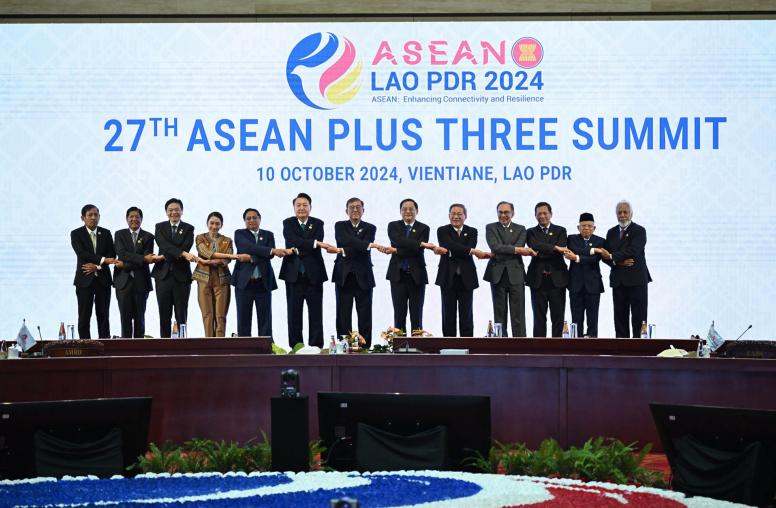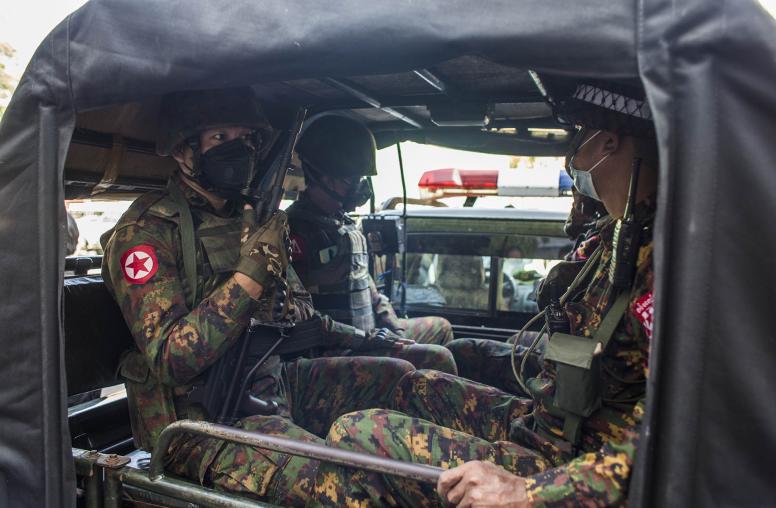In Myanmar, the State the Generals Seized Is Coming Apart
As ethnic armies expand their reach and resistance groups take up arms, post-coup Myanmar is dissolving into pieces.
Over the past six months under the junta’s “care,” the chaos and turmoil sparked by the coup has moved the country past the brink of failed state status. Growing armed resistance is emerging in the shrinking area where the military’s unbridled brutality has preserved its veneer of control. In liberated zones and particularly in regions controlled by ethnic armed organizations (EAOs), new forms of governance and even sovereignty are taking shape in the vacuum left by Commander-in-Chief Min Aung Hlaing’s war on political reform.

Over the past six months under the junta’s “care,” the chaos and turmoil sparked by the coup has moved the country past the brink of failed state status. Growing armed resistance is emerging in the shrinking area where the military’s unbridled brutality has preserved its veneer of control. In liberated zones and particularly in regions controlled by ethnic armed organizations (EAOs), new forms of governance and even sovereignty are taking shape in the vacuum left by Commander-in-Chief Min Aung Hlaing’s war on political reform.
The disintegration of the Myanmar state has significant implications for the region, and especially for China. Transnational criminal activity is expanding as the military and militia groups ramp up efforts to finance struggles over control. Trade and commerce are suffering as grand connectivity schemes are torn apart. Most importantly, a devasting humanitarian disaster has spilled across the region as the junta continues an iron-fisted attempt to control the country. For China, which works with the junta, state collapse has threatened national security, with mortar bombs and COVID-19 crossing the border, harming Chinese nationals.
While no one can predict Myanmar’s end state with certainty, the trend lines are clear: The country is being pulled into pieces.
The Rise of the New Armed Groups: Community Wars Against Oppression
Following a bloody crackdown on largely peaceful protests throughout February, hundreds of thousands of Burmese went underground and many began to plot violent struggle against the army. Organized under names such as the Federal Self Defense Force Kyaukse, the Chinland Defense Force, the Sagaing People Defense Force and the Myanmar Civilian Defense Force, the groups obtained basic military training from EAOs that have long battled the military for autonomy. Some have even resorted to online self-help guides.
With limited training and rudimentary arms, these groups have mounted astonishing resistance to the army’s efforts to re-impose military rule.
- In May, Chin State, which borders India, was the focus of this new form of warfare when several bands of local defense forces held their own against the Tatmadaw, as the Myanmar army is known, and ultimately forced the military to engage in cease-fire negotiations.
- Days later, violence exploded in Kayah State, which borders Thailand, between a new defense force and the army’s 66th division.
- In June, urban warfare broke out in Mandalay between local defense groups and junta security forces. The fighting continued into July and August with one such group assassinating a junta administrator.
- Also in July, Sagaing, another state on India’s border, saw extremely heavy fighting between the Tatmadaw and a local defense force now supported by the Kachin Independence Army (KIA). The local resistance reported killing over 180 junta troops.
New guerilla groups continue to emerge daily in nearly every corner of the country where the military is present, with growing focus on key urban spaces such as Yangon. In response, the military has deployed increasingly lethal violence against the population, launching airstrikes in Kayah and Chin States and threatening to burn entire villages in Mandalay. It has also mobilized vigilante groups known as Pyu Saw Htee to assassinate Peoples’ Defense Force (PDF) leaders and engage in psychological warfare. Although this assault has displaced several hundred thousand people, the PDFs have doubled down, convinced that victory is not out of reach.
Meanwhile, the National Unity Government (NUG), an underground parallel government formed by deposed parliamentarians, has established its own Defense Force that it hopes will become a federal army and released a code of conduct for all defense forces in the country. While many of the anti-coup defense groups may have an affinity for the NUG, they are atomized, launching operations on an ad hoc basis or sometimes in coordination with powerful EAOs.
A Romance of Kingdoms: Kachin, Rakhine, Wa and Shan States
Even before the coup, the Tatmadaw was stretched to the limit, fighting the Arakan Army (AA), a relatively new and powerful adversary in Rakhine State, and the AA’s allies in the China-Myanmar border area.
Now, the chaotic aftermath of the coup has positioned the three most powerful EAOs — the KIA, the United Wa State Army (UWSA) and the AA — to dramatically expand their capacity and turf.
The erosion — or termination — of military control is evident in the states bordering China and the Bay of Bengal, which perhaps not so coincidently represent the entry and exit points of China’s planned economic corridor through Myanmar.
Kachin: The Kachin Independence Army, which has its stronghold on the border with China, has taken advantage of the Tatmadaw’s illegitimacy to enlarge its control and authority. It has opened an offensive against the Tatmadaw, provided training and support to the PDFs and hosts representation of the NUG.
The KIA has seized multiple strategic Tatmadaw outposts since March and captured two key points on the main trade route between China and Myanmar. Its zone of influence has expanded deeper south into neighboring Sagaing and Shan States, while its administrative grip tightens in territory it controls. The KIA is now issuing public health orders in the Tatmadaw controlled capital of Myitkyina, while also implementing its own vaccination campaign.
Significantly, the KIA’s support for local defense forces and the NUG have helped maintain stability in Kachin and surrounding areas. At the same time, Kachin political actors have built significant influence within the parallel government, which selected a prominent ethnic Kachin leader as acting president.
Rakhine State: The Arakan Army has leveraged the coup to consolidate its rule in Southern Chin and Rakhine States and to expand its autonomy and governance while maintaining an informal cease-fire with the Tatmadaw initiated just before they seized power.
The AA has established a health committee to lead Rakhine’s fight against COVID-19, set up administrative offices and extended its control to the deep south of the state, including the area around a planned strategic Chinese port and special economic zone in Kyaukphyu. The AA has prevented the emergence of any civil disobedience movements or PDF groups in its territory. Instead, it has focused on ejecting the majority of junta administrators. It hopes to replicate the UWSA model in northern Shan State, where the Wa have full control.
Wa and Shan States: The United Wa State Army is the most powerful of Myanmar’s EAOs and controls territory in two enclaves in Shan State: one the size of Kuwait along the China-Myanmar border and a second the size of Jamaica on the Thai-Myanmar border. UWSA administration of most of the northern enclave is written into Myanmar’s constitution, but this falls short of Wa’s political ambitions for a constitutionally mandated autonomous Wa State encompassing all territory under its control.
Two other ethnic Shan armies are located between the Wa enclaves — the Shan State Army-North (SSA-North), and the Shan State Army-South (SSA-South). The former is a close ally of the UWSA; the later a historical adversary.
The SSA-South signed the National Cease-fire Agreement in 2015, and as its ties with the Tatmadaw grew closer, it gradually attempted to expand its influence further north into Shan State, posing a threat to the UWSA. The Tatmadaw was generally supportive of the southern group’s expansion, as it feared growing UWSA and Chinese influence throughout Shan State to the Thai border.
Following the coup, the SSA-South was suddenly in a weak position without allies. That provided its northern adversaries with a strategic opening. Starting in May, the Wa have supported a significant military campaign by the SSA-North, which has pushed the SSA-South out of strategic positions in the north of Shan State. The Wa-supported campaign not only threatens the existence of the southern army and its political wing, it also puts the UWSA in a position to considerably enhance its influence across Shan State through the territory between its two enclaves.
Stable Peripheries, Collapsing Core
In short, while the three most powerful EAOs diverge in their views on the battle between the deposed civilian government and the military, each has capitalized on chaos at the country’s center to pursue long-held political ambitions:
- The Kachin seek to balance the necessity of strong ties with China against a desire to maintain an open, stable and democratic society that supports the NUG and PDFs and curbs Tatmadaw influence in Kachin.
- The UWSA shares a political system with China. It aims to expand its authority deeper into Myanmar, and profit by extending Chinese influence to the Thai border.
- The AA seeks no less than what the Wa have achieved politically, but with less reliance on China.
To advance these disparate political objectives, the EAOs will support one another against a common enemy — the Tatmadaw. That, however, marks the limit of their unity.
China and the Future
China maintains close ties with all three groups and as of August 5, effectively established full relations with the junta. While Beijing refuses to engage with the NUG and other pro-democracy actors, it does have influence with both through other powerful, pro-NUG EAOs such as the KIA.
As USIP highlighted earlier, chaos in Myanmar is China’s nightmare, and the country’s current trajectory is toward sustained violent turmoil. The resulting economic and governance collapse has already deeply damaged China’s national security, notably by unleashing yet another outbreak of COVID-19 across the border into Yunnan. Meanwhile, escalating combat in Myanmar has led to mortar fire landing in Chinese territory.
Yet, China’s response has been largely to support the moves of all four of these parties to conflict to meet its objectives: It needs stability in the borderlands under KIA and the UWSA control and has interest in business initiatives that benefit from the AA’s stabilization of Rakhine State. Thanks largely to AA’s ability to push Bamar authorities out of the state, Chinese companies have advanced key infrastructure for China’s planned Indian Ocean port — a 30-year goal.
At the same time, China supports the Tatmadaw’s battle against the NUG and PDFs, which it sees as a source of instability and as backed by what China views as “hostile foreign influence.”
Collectively, these efforts weaken the little remaining glue that holds the country together and increase the desperation of those on all sides who maintain a vision of Myanmar as a unified state.



